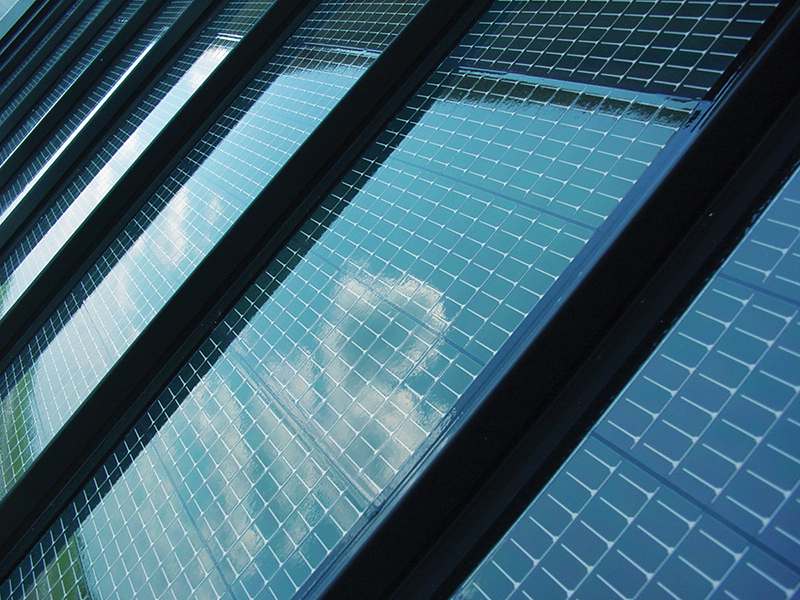
Paper-Thin Plastic Film Soaks Up Sun to Create Solar Energy
Originating Technology/NASA Contribution
A solar cell is a semiconductor device that converts photons, or light, into electricity. The most widely used solar cells today are made from wafers of mono- or poly-crystalline silicon.
Mono-crystalline silicon, or single-crystal silicon, is produced by growing a large pure crystal of silicon in a furnace. The pure crystal is then sawed into wafers and assembled in an array. The resulting silicon is highly efficient, but expensive and time-consuming to mass-produce. Further, because the silicon has to be cut prior to assembly, approximately 50 percent of material goes unused, and is therefore wasted.
Poly-crystalline silicon, or multi-crystal silicon, is created by casting molten silicon in blocks. While this process is a little less expensive and faster than the process used for growing a single crystal, the resulting multi-crystal silicon is less efficient than its single-crystal counterpart.
Although less commonly used, a third type of solar cell, called a thin film solar cell, can counterbalance many of the disadvantages associated with mono- and poly-crystalline silicon manufacturing by using only a fraction of pure silicon. Thin film solar cells are made by depositing a very thin layer of silicon (or another semiconductor substance, depending upon the application) on a very thin supporting material, such as glass, plastic, or metal foil. This process is known as chemical vapor deposition.
A non-crystallized silicon known as amorphous silicon is the semiconductor material most frequently chosen for deposition, because it is a strong absorber of light. According to the U.S. Department of Energy, amorphous silicon absorbs solar radiation 40 times more efficiently than single-crystal silicon, and a thin film only about 1-micrometer (one one-millionth of a meter) thick containing amorphous silicon can absorb 90 percent of the usable light energy shining on it. Peak efficiency and significant reduction in the use of semiconductor and thin film materials translate directly into time and money savings for manufacturers.
Thanks in part to NASA, thin film solar cells derived from amorphous silicon are gaining more and more attention in a market that has otherwise been dominated by mono- and poly-crystalline silicon cells for years. At Glenn Research Center, the Photovoltaic & Space Environments Branch conducts research focused on developing this type of thin film solar cell for space applications. Placing solar cells on thin film materials provides NASA with an attractively priced solution to fabricating other types of solar cells, given that thin film solar cells require significantly less semiconductor material to generate power. Using the super-lightweight solar materials also affords NASA the opportunity to cut down on payload weight during vehicle launches, as well as the weight of spacecraft being sent into orbit.
Iowa Thin Film Technologies, Inc., of Boone, Iowa, worked closely with the Photovoltaic & Space Environments Branch so that both parties could broaden their understanding of thin film solar cells made from amorphous silicon. The commercial payoff of this alliance has now been realized, with terrestrial trickle-downs coming in the forms of solar-powered headset radios for recreational use and battery chargers and solar tents for military operations.
Partnership
In November 1989, Glenn awarded Iowa Thin Film Technologies with a $50,000 Phase I Small Business Innovation Research (SBIR) contract to research the potential for a lightweight and flexible thin film solar cell that uses amorphous silicon as a semiconductor source, for air and space applications. With this initial-phase funding, Iowa Thin Film Technologies demonstrated that development of the solar technology was viable and, thus, was awarded a $500,000 Phase II contract to move ahead with the manufacturing process, which then occurred over the course of 2 years. Funding from Glenn supported the research and development programs of Iowa Thin Film Technologies in the early years of the company and helped improve the company’s process for depositing solar cells on rolls of thin, flexible plastic substrate.
Iowa Thin Film Technologies also received funding for this project from several other government agencies, as well as from private resources. The private investments provided the financing necessary for the company to build a complete production facility. In addition to expanding its workspace, the company expanded its workforce, growing from just a few employees to 12 full-time and 8 part-time employees.
Because of the NASA SBIR support that led to new technology and helped create new jobs, the company today shines as a leading producer of thin film photovoltaics.
Product Outcome
PowerFilm Solar, the solar division of PowerFilm, Inc. (the company previously known as Iowa Thin Film Technologies), manufactures and markets a differentiated line of next-generation, amorphous silicon, thin film solar panels that can easily and economically be integrated with consumer and military products. The amount of amorphous silicon used in the panels is as low as 1 percent of the amount used in traditional crystalline silicon solar panels, according to PowerFilm Solar.
These thin film solar panels, branded as PowerFilm solar panels, are constructed using a process called monolithic integration, which is the automatic, built-in connection of individual solar cells. According to the company, monolithic integration improves durability and reduces cost by eliminating the need for expensive and failure-prone manual collection of individual solar cells. It further noted that it is the first and only company in the world to manufacture and sell monolithically integrated semiconductors on a flexible polymer substrate. During the manufacturing process, PowerFilm Solar uses its proprietary “roll-to-roll” manufacturing technology platform. (Roll-to-roll processing is the action of creating electronic devices on a roll of flexible plastic or metal foil.)
“Imagine taking paper-thin plastic film and making it generate power again and again. That’s what PowerFilm is and does,” claimed Michael Coon, the company’s chief operating officer. “This is not your father’s solar technology from the ’70s. PowerFilm’s durable plastic base is superior to fragile glass or corrosive metal,” he added.
Available in a variety of standard and custom configurations to meet specific voltage, current, and environmental needs, the rollable PowerFilm products boast a durable and aesthetically pleasing design, and are quickly adaptable within their intended market, be it commercial or military. Moreover, they are not hazardous to human health, since amorphous silicon is completely free of cadmium (a naturally occurring metallic element known to produce toxic effects in humans), unlike many other solar technologies.
Across the board, PowerFilm Solar’s PowerFilm commercial products are experiencing very strong sales. One of the company’s first offerings sprung from its research partnership with NASA was the HR-1 Soltronix Solar Rechargeable AM/FM Headphone Radio. Featuring a breakthrough combination of PowerFilm solar technology and premium sound, the HR-1 headphone radio automatically recharges itself when in sunlight, even while the user is listening to it. (One hour of charging in full sunlight provides 1 to 3 hours of listening.) It will even recharge under interior house lighting or on cloudy or rainy days, albeit at much slower rates. When fully charged, the headphone set will play for more than 20 hours, even in the dark.
Other features include an internal antenna for powerful reception, a dual headband for added comfort, all-weather durability (Some users have remarked on the usefulness of the headset while walking/jogging in the rain or while boating.), and an extended bass range for setting graphic equalization to a listener’s liking.
The sophisticated solar cells also serve as precision chargers for AA batteries. In 2005, PowerFilm Solar launched the PowerFilm Foldable Solar Charger that can recharge up to four AA batteries at a time, to optimum level, without inducing damage associated with overcharging. “Unlike other solar chargers for AA batteries, this new charging circuit does not get confused from variations in current typically seen from a solar panel,” noted Frank Jeffrey, PowerFilm’s chairman.
The technology, comprised of a rugged fabric that houses the lightweight, flexible solar panels, is being marketed in partnership with Johnson Outdoors, Inc., a recreational product manufacturer. In addition to this commercial version, PowerFilm Solar has introduced a military version that is ideal for soldiers in the field, especially in remote locations.
Also in 2005, PowerFilm Solar teamed up with the U.S. Army to supply PowerFilm-equipped tents. The largest tent ordered by the Army is a canopy that can provide up to 2 kilowatts of power. “This is enough energy to power up to 66 laptop computers or 260 cell or satellite phones [when the sun is shining],” said Steve Martens, the president of PowerFilm. “A second, smaller model can produce enough power for 5 laptop computers or 24 cell or satellite phones,” he added. The power generated by each tent is stored in a bank of batteries.
The solar tents help meet the Army’s growing demand for rapid-response rates and portable, remote power, and eliminate the need for noisy generators, spare batteries, and excessive fuel storage.
PowerFilm® and Soltronix HR-1® are registered trademarks of PowerFilm, Inc.
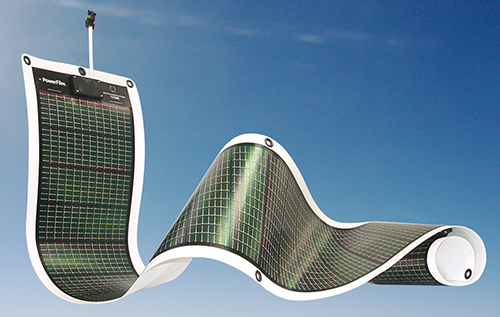
PowerFilm Solar manufactures thin, flexible solar panels by way of a proprietary, low-cost, “roll-to-roll” process. The rollable solar panels are monolithically integrated, which eliminates the need for damage-prone manual connections of individual solar cells.
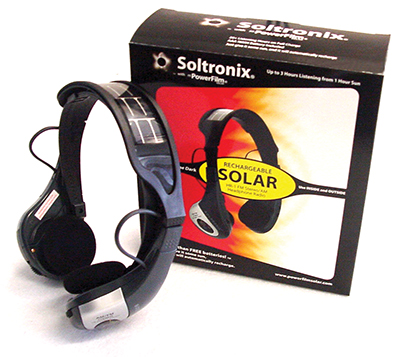
The Soltronix HR-1 solar-rechargeable AM/FM Headphone Radio eliminates the cost and inconvenience of replacing batteries. The portable and powerful system automatically recharges itself when in sunlight, even while listening.
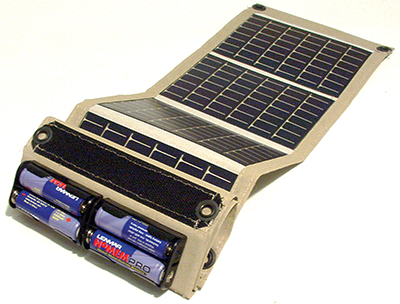
The PowerFilm AA Foldable Solar Charger provides portable power for charging AA rechargeable batteries. The charger automatically begins charging once unfolded, and a light informs the user when the batteries are fully charged.
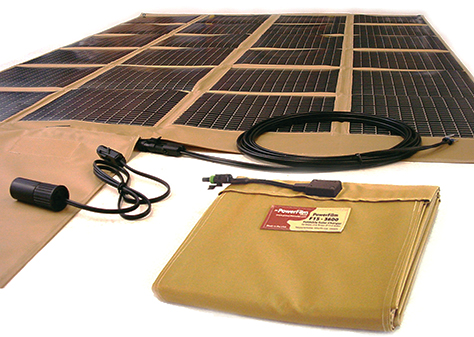
The PowerFilm 60-Watt Foldable Solar Charger, the largest in PowerFilm, Inc.’s line of foldable solar chargers, is very lightweight (2.6 pounds), considering the amount of power it produces (3.6 amps at 15.4 volts).
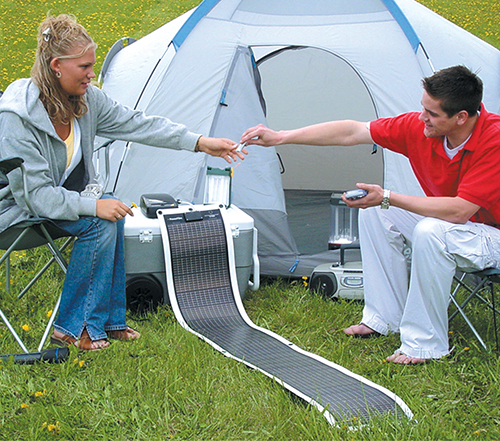
The flexible, thin film solar cell can be a source of power for laptops, MP3 players, portable televisions, and other items that might be used during outdoor recreational activities.

Thin film solar cells derived from amorphous silicon, pictured here, are gaining more and more attention in a market otherwise dominated by mono- and poly-crystalline silicon solar cells.













